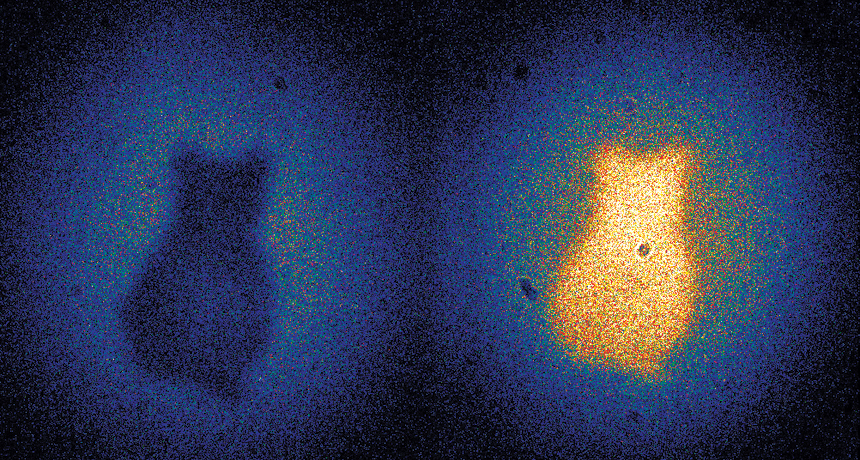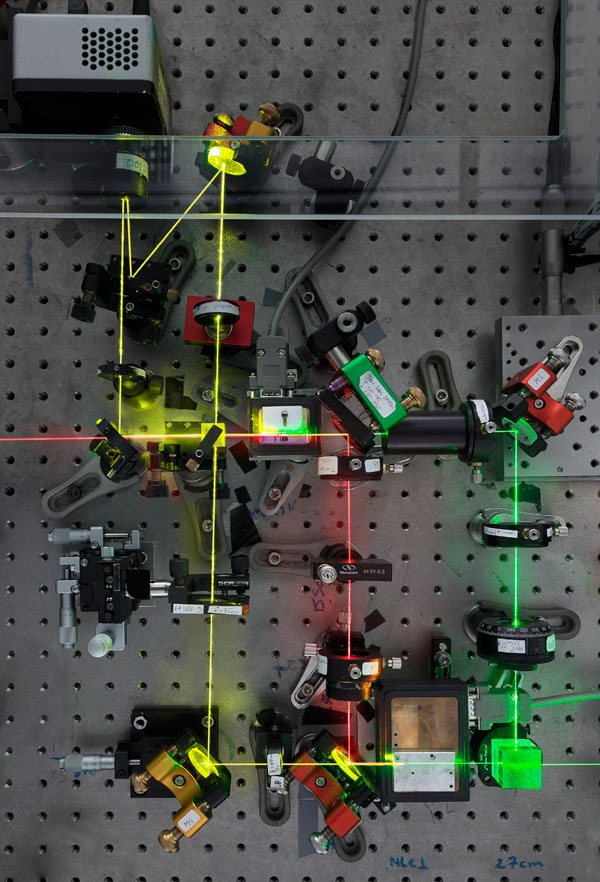Blind quantum camera snaps photos of Schrödinger’s cat
Laser experiment takes photographs without detecting light from feline subject

GHOSTLY IMAGE Quantum weirdness allowed researchers to snap this photograph of a cat-shaped cardboard cutout using light that never directly interacted with the kitty.
Gabriela Barreto Lemos
- More than 2 years ago
Exploiting the same quantum quirk that spawns Schrödinger’s undead cat in the famous thought experiment, a research team snapped a portrait of a cat-shaped hole in cardboard without collecting any light bouncing off the two-dimensional kitty. This blind camera, comprising lasers and crystals, could help scientists illuminate microscopic worlds difficult to picture using existing techniques, the team reports in the Aug. 28 Nature.
“We didn’t detect any photons coming from the object, but we got a surprisingly clear image,” says physicist and lead author Gabriela Lemos of the University of Vienna.
The experiment marks the first time an image has been produced using light that never interacted with the subject. Existing quantum imaging techniques such as ghost imaging (SN: 9/12/09, p. 12) still require light from the object to complete the picture.
Lemos acknowledges that the physics that powers her team’s new experiment seems counterintuitive. “It doesn’t really make much sense to us either, and I love these things that challenge our imagination and intuition.”

Photons within the left half of the split beam enter a special crystal that transforms each incoming green photon into two photons, a yellow and a red. A special reflector directs the red photons toward a piece of cardboard with a 3-millimeter, cat-shaped hole cut into it. While some light passes cleanly through the opening, other photons smack into the cardboard.
The setup then aligns the remaining red photons and the right half of the green laser beam into another crystal that converts green light into red and yellow light. Where the incoming red photons blocked by the cardboard should be in the crystal, the newly created yellow photons appear, having unwittingly been created with information about the size of the cat hole. It’s at this moment that information jumps from the red beam to some of the newly created yellow photons.
Finally, mirrors direct the left and right yellow light beams together and toward a sensor (the red photons are tossed out). On the outside of the sensor where the yellow photons from the second crystal carry information, the two beams don’t interact. Inside the cat outline, however, the photons interfere with one another, creating a telltale light pattern. Although the red photons interacted with the cat, it’s the yellow light that paints the image — photons that never went near the cardboard kitty.
Lemos says the image quality took her by surprise. “I was expecting something horrible, something completely blurred,” she says. “We didn’t even need long exposure times; it just took a second. When we moved around the cardboard, we immediately saw the change in the image.”
The method could provide a big benefit for scientists imaging tiny structures such as integrated circuits and living cells, Lemos suggests. The quantum camera can use one wavelength of light to interact with an object and then shift the information to a light range that’s more easily measurable, she says.
Seth Lloyd, a mechanical engineer at MIT, says that while the setup seems promising, time will tell if it outperforms existing imaging techniques. For now, Lloyd says, “the work is extremely cool — it uses quantum mechanics to do things that sound extremely improbable if not impossible; it makes the science elegant.”
Editor’s Note: This article was updated September 2, 2014, by changing the top image. The image in the article now is the “cat portrait” taken with the experimental setup described, rather than a closely related one.







